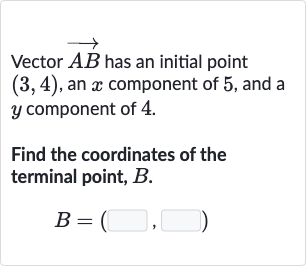AI tutor
Welcome to Bytelearn!
Let’s check out your problem:

Vector has an initial point , an component of , and a component of .Find the coordinates of the terminal point, .
Full solution
Q. Vector has an initial point , an component of , and a component of .Find the coordinates of the terminal point, .
- Finding x-coordinate of terminal point: The component of the vector represents the horizontal change from the initial point to the terminal point. Since the component is , we add this to the -coordinate of the initial point to find the -coordinate of the terminal point. (initial -coordinate) + ( component) =
- Finding y-coordinate of terminal point: The y component of the vector represents the vertical change from the initial point to the terminal point. Since the y component is , we add this to the y-coordinate of the initial point to find the y-coordinate of the terminal point. (initial y-coordinate) + (y component) =
- Coordinates of terminal point B: Combining the results from the previous steps, we find that the coordinates of the terminal point B are .
More problems from Write equations of cosine functions using properties
QuestionGet tutor help
QuestionGet tutor help
QuestionGet tutor help
QuestionGet tutor help
QuestionGet tutor help
QuestionGet tutor help
QuestionGet tutor help
QuestionGet tutor help
QuestionGet tutor help
